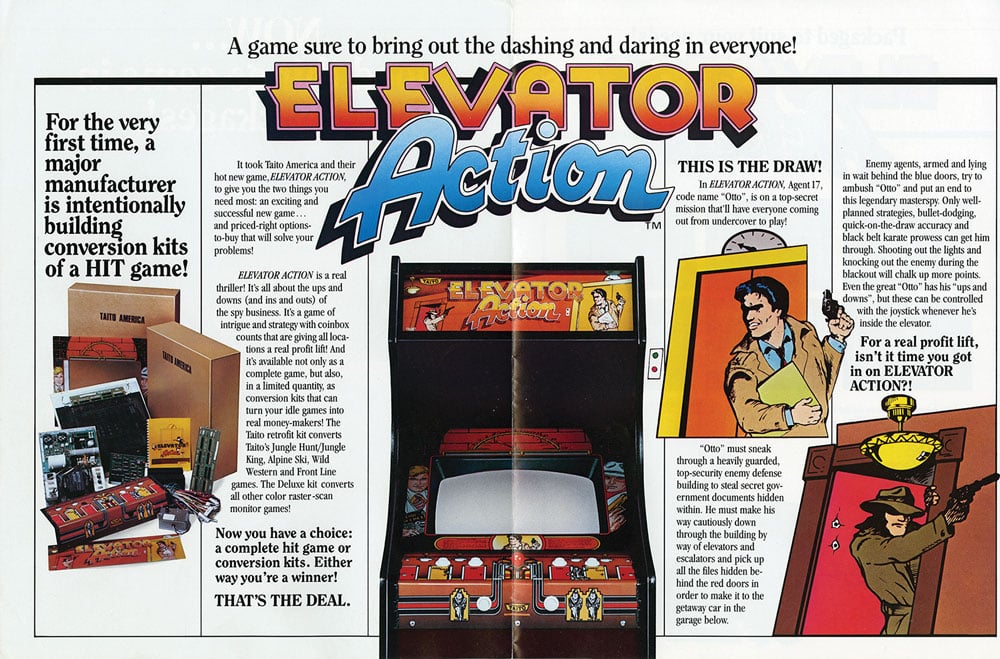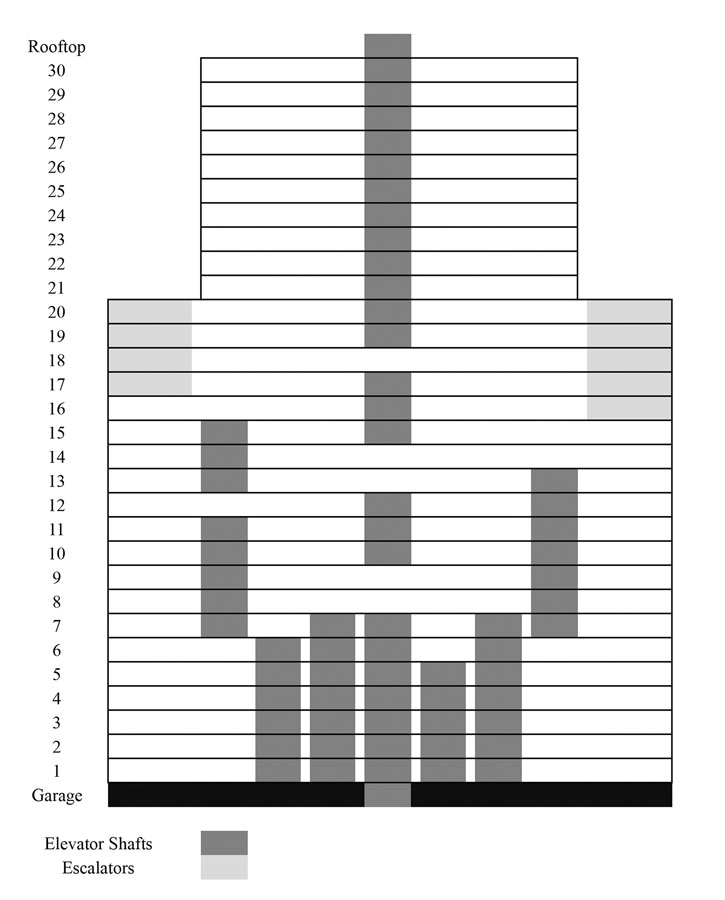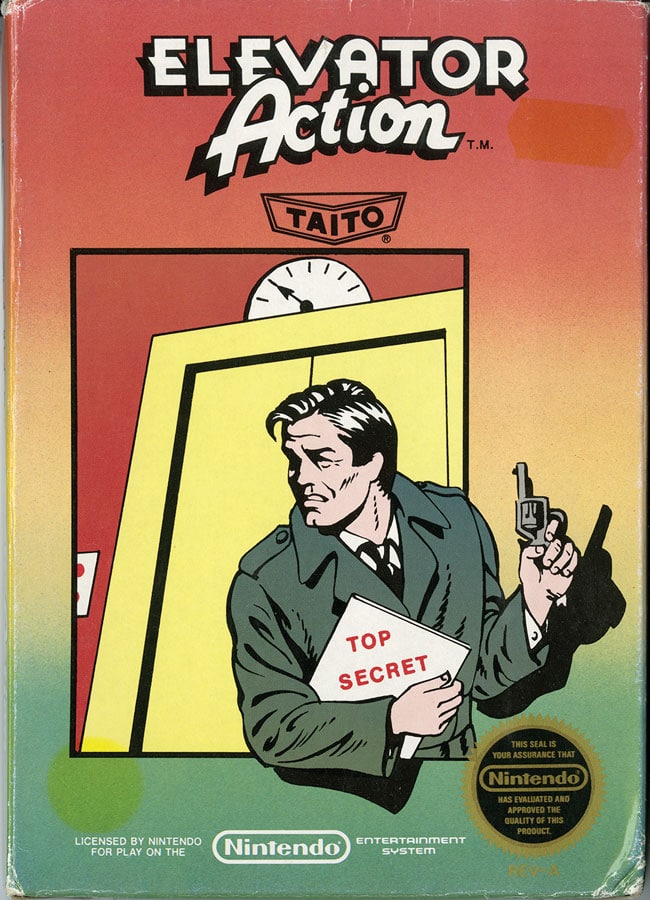“Elevator Action”
Mar 1, 2016

This 1983 Golden Age console marked the intersection of the worlds of vertical transportation and video games.
The phrase “Golden Age” evokes a variety of images, such as the Golden Age of Television and the Golden Age of Hollywood. Merriam-Webster defines the phrase as referring to “a period of high artistic or cultural development.” The Oxford English Dictionary provides both its origin and a more comprehensive definition:
“The first and best age of the world, in which, according to the Greek and Roman poets, mankind lived in a state of ideal prosperity and happiness, free from all trouble or crime. Hence, the period in which a nation, etc., is at its highest state of prosperity, or in which some department of human activity is at its acme of excellence.”
While it would be intriguing to attempt to define the Golden Age of vertical transportation, this investigation concerns a different type of technology (and associated activity) at its perceived “acme of excellence”: the Golden Age of Video Arcades. Although the dates for this era differ, they all encompass 1983, the year the worlds of vertical transportation and video games intersected with the debut of “Elevator Action™.”

The game was developed by the Taito Corp. of Japan and distributed in the U.S. by the Taito America Corp. In 1983, video arcade owners received an advertising brochure titled “Now… good things come in all packages!” that announced the new game, which was available as a complete game console and as a conversion kit to retrofit existing consoles (Figure 1). The game was described as “a real thriller” that allowed players to experience “the ups and downs (and ins and outs) of the spy business.” The game’s basic premise and operation was described as follows:
“In ‘Elevator Action,’ Agent 17, code name ‘Otto,’ is on a top-secret mission that’ll have everyone coming out from undercover to play! ‘Otto’ must sneak through a heavily guarded, top-security enemy defense building to steal secret government defense documents hidden within. He must make his way cautiously down through the building by way of elevators and escalators and pick up all the files hidden behind the red doors in order to make it to the escape car in the garage below. Enemy agents, armed and lying in wait behind the blue doors, try to ambush ‘Otto’ and put an end to this legendary master spy. Only well-planned strategies, bullet-dodging, quick-on-the-draw accuracy and black-belt karate prowess can get him through. Shooting out the lights and knocking out the enemy during the blackout will chalk up more points. Even the great ‘Otto’ has his ‘ups and downs,’ but these can be controlled with the joystick whenever he’s inside the elevator.”
However, this description only hints how Agent 17 (and, thus, the game players) must use elevators and escalators while working their way through the building.
“Elevator Action” begins with Agent 17 landing on the roof of a 30-story building. Fortunately for him, an elevator on the roof provides access to the building below; thus, he experiences the elevator/escalator system from the top down. Of course, the building’s elevatoring is more easily explained in a typical manner, from basement to rooftop. The first floor is served by five elevators, one of which also serves the basement garage. One elevator serves floors 1-5, one serves floors 1-6, and three serve floors 1-7. The seventh floor functions as a basic sky lobby and provides access to two elevators: one serving floors 7-11 and one serving floors 7-13.
Additional elevators include one serving floors 10-12, one serving floors 13-15, one serving floors 15-17 and one serving floors 19-30 (including the rooftop). Floors 17-20 are also served by two escalators per floor, and the 16th floor has one escalator, which provides access to and from the 17th floor. Thus, the building’s elevatoring diagram is extremely odd, with the service divided into somewhat arbitrary sections (Figure 2). This planning, coupled with the fact that no elevators serve the 18th floor, reflects the game designer’s goal to make it as difficult as possible to navigate through the building, which was, of course, the idea.
Additional details worth noting include the fact that two shafts featured a kind of double-decker elevator, and, as is implied by the gameplay, each elevator car has two door openings: Agent 17 can exit a car to either the right or left. However, the car openings do not have corresponding doors on either the cars or landings. Agent 17 can shoot at enemy agents while riding the elevator, run through a car when it is stopped at a floor, and, if the car is above the floor he occupies, jump over the shaft opening. The ability to jump over the shaft is made possible by the absence of the elevator cables, which extend upward from the top of the car. (No counterweight cables are depicted.) Agent 17 can also ride on top of a car (if needed). He is, however, not allowed to disregard all aspects of elevator operation: he can be crushed by an elevator car if he doesn’t jump off the top in time or if he is caught standing at the bottom of a shaft. Given the critical importance of elevator safety for passengers and industry professionals, it is, perhaps, challenging at this point to remember that this is “only a game.”
Taito’s advertising graphics for “Elevator Action” provide interesting depictions of elevator doors (in spite of their absence during gameplay) and position indicators. The arcade console included a plastic banner across the top that featured Agent 17 standing in front of closed elevator doors topped by a dial indicator (Figure 3). The indicator was rendered as a schematic with no floor numbers. The cover of the maintenance and operator’s manual provided to arcade owners featured what may be characterized as an “old-fashioned” dial indicator over the door, which includes floor numbers 1-30 (Figure 4). This image also included modern-looking up/down arrow lights located to the right of the car. This redundancy is matched by the depiction of a brown-haired Agent 17 emerging out of the “n” in “Action” and a blonde Agent 17 falling backwards near the “E” in elevator. In 1987, a Nintendo Entertainment System (NES) version of the game (featuring the same graphics as the original) that used the same 1983 advertising graphics was released (Figure 5).
Playing the game today serves as a reminder of how far computer graphics and computer games have come since 1983. Although the arcade version of the game no longer exists, “Elevator Action” can be played on an old NES console, or, the same version can be played via download on a Wii console via its “Virtual Console.” The latter method was employed for this investigation, which allowed the research phase to include time allotted to playing a vintage video game.
The game is surprisingly hard to play: enemy agents constantly appear attempting to shoot Agent 17, and the placement of the elevators and escalators require skill in moving back and forth, as well as up and down. When Agent 17 is in an elevator, he can control the car’s movement; however, when standing in the hallway, he must wait for an elevator to arrive. There were also several distractions during early gameplay (perhaps unique to an elevator historian): observing how the elevators and escalators are rendered, noting the presence of two cars in a single shaft, wondering whether the elevator cables would stop bullets from passing through the open shaft (they do), and trying to figure out the elevatoring of the building (Figures 6-9). Thus, even though players are given three “lives,” it took several attempts (more than you might think) to safely reach the garage and move to the next level. At this point, the player realizes that each level is essentially the same, with the only difference being the locations of the “red doors” that reveal the location of the secret documents.
As has often been noted in previous articles, vertical transportation has a uniquely powerful cultural presence. The fact that this technology served as the inspiration for one of the 1980s’ most popular arcade games is one more reminder of this fact. And, it is important to note, the presence of elevators in video games did not stop with “Elevator Action.”
In 1991, an upgraded version of the game was released for play on the Nintendo Game Boy system. This was followed by “Elevator Action II/Elevator Action Returns” (1994), “Elevator Action EX” (2000), “Elevator Action Old & New” (2002), “Elevator Action 3D” (2006), “Elevator Action: Death Parade” (2008) and “Elevator Action Deluxe” (2011). Your humble historian was tempted to find, play and compare all of these versions with the original. (With each version, the graphics and gameplay improved dramatically). However, the time spent playing the original game on his living room TV while having to repeatedly state, with great sincerity, “I’m not playing, this is research,” has resulted in the perceived need to wait (perhaps for some time) before embarking on a further exploration of elevator video games. 🌐
Get more of Elevator World. Sign up for our free e-newsletter.
















